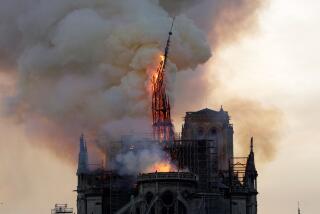Tradition Wins as Moscow Puts Cathedral Design to Vote : Soviet Union: It will be the first new Russian Orthodox edifice in 70 years. And the public wants cupolas.
MOSCOW — One design looked like the Taj Mahal. Another, sporting a minaret-like tower, could have been a mosque. And a third might have been an import from Disney’s “Magic Kingdom.”
Interesting, perhaps, exotic even, but clearly not what the thousands who thronged an exhibition hall on the Moscow River on Sunday had in mind for Holy Trinity Cathedral, the first new Russian Orthodox church to be built in this country in 70 years.
It was a traditional crowd, and they wanted a traditional design for the edifice that is to commemorate 1,000 years of Russian Christianity.
“The cathedral should exemplify the magnificance of the Russian Orthodox Church, its connection with the history of the great Russian people, its activity, full of hardship, aimed at creating a united, multinational, strong state,” wrote an anonymous 64-year-old on his ballot. “That is why a modernist project, to my mind, cannot reflect the significance of Christianity in Russia.”
The votes of these ordinary Russians will help a church panel narrow the design choice to eight finalists by the end of the month, with the winning entry to be selected in July.
Meanwhile, both the exhibition itself and the extraordinary attendance are testimony to the enormous change in church-state relations under President Mikhail S. Gorbachev’s perestroika program of reforms.
It is symbolic that one of the two favorite designs submitted for the new church is an exact image of Christ the Savior Cathedral. Built in the 19th Century to commemorate Russia’s defeat of Napoleon, the central Moscow cathedral was one of the largest in Europe until the late dictator Josef Stalin ordered it razed in 1931, to be replaced eventually by a heated, year-round outdoor swimming pool.
That was one of at least 40,000 Russian Orthodox churches destroyed here after the 1917 Bolshevik Revolution made atheism the official dogma. Thousands more were confiscated and turned into warehouses.
Under Gorbachev, 1,000 churches have reportedly been given back to the Patriarchate, and last fall the leadership permitted the first religious service since 1918 within the Kremlin walls at Uspensky Cathedral, where czars were once crowned and church leaders buried.
“This is the first time (since the revolution) that the Russian Orthodox Church has gotten so much freedom,” said Valentin V. Solodovnikov, a construction engineer formerly employed by the Foreign Ministry to build Soviet embassies abroad but now working for the Patriarchate on the cathedral project.
“If you visit any church you’ll see crowds. There are many young people. Lots of baptisms and weddings. In today’s unquiet times, people tend to go to church and find peace there,” added Solodovnikov, himself a professed non-believer.
“The policy today gives ground for a revival of people’s interest in the church,” agreed Elena Yegorova, who came to look at the competing designs with her husband. “People feel freer.”
So many came Sunday--young and old, believers and atheists, men and women--that the biggest problem was finding paper for them to write down their impressions. Exhibition workers ran out of pre-printed questionnaires by noon, with five more hours of crowds to come.
One teen-age boy had a small silver cross dangling from his pierced left ear. Many visitors had learned of the exhibition from a lengthy segment about it on the main television news program Saturday night.
It was first announced in 1988, during the church’s millennial celebrations, that a new cathedral would be built, and last year, Moscow Patriarch Pimen announced an open contest to come up with the best design.
A wooded hilltop site overlooking the scenic Tsaritsyn Ponds in southeast Moscow has already been set aside for the cathedral, and completion is targeted for the year 2000. The church, to be financed entirely from contributions, is to hold up to 10,000 people, have underground parking for 700 cars and be surrounded by a park “with fountains, decorative ponds and exotic plants.”
By last Dec. 1, about 320 designs had been received from architects and a few amateurs in more than 50 cities. Many submitted not only drawings but colorful architects’ renderings of their designs, and even scale models. Those were the materials put on public exhibition here.
Most--but not all--featured at least a few traditional Russian Orthodox cupolas, or “onion domes,” and one proposal had 45. But beyond that, the architects clearly let their minds roam. There were many modernistic designs, which drew large but mostly critical crowds Sunday.
“Take the cupolas off and it looks like a railroad station to me,” grumbled one young man about one design.
More to Read
Sign up for Essential California
The most important California stories and recommendations in your inbox every morning.
You may occasionally receive promotional content from the Los Angeles Times.










